Prescribed Burns Are Good Medicine for the Land
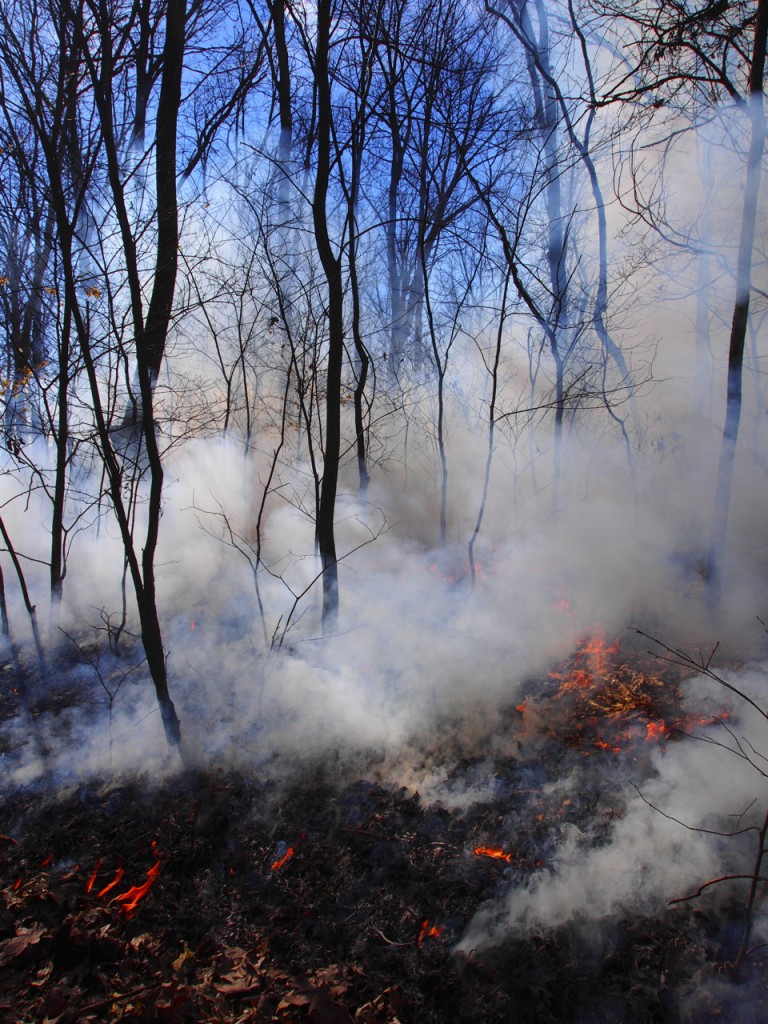
While flame and smoke look really impressive, the truly impressive parts are after the prescribed burn is over, as this land management tool plays an important part in restoring woodlands and prairies to health. Photo courtesy Tom Rollins, ThomasRollinsPhotography.com
We built a really big fire at White Rock Nature Preserve on the last day of March. Earlier in the month, some of us helped with an even bigger fire at Salt Lick Point Land and Water Reserve and another at Fults Hill Prairie Nature Preserve, and at Buettner Glades Natural Area site. Why do this? Why deliberately set a fire? Some “just-the-facts-ma’am” language in the Illinois Prescribed Burning Act, passed into law in 2007, offers our basic reasons:
Prescribed burning is a land management tool that benefits the safety of the public, the environment, and the economy of the State. Therefore, the General Assembly finds that:
(1) Most of the State’s natural communities require periodic fire for maintenance of their ecological health. Prescribed burning is essential to the perpetuation, restoration, and management of many plant and animal communities. Significant loss of the State’s biological diversity will occur if fire is excluded from these fire-dependent communities.
(525 ILCS 37/5)
Prescribed fire is done with strict adherence to safety guidelines. A burn plan is written for each site, and includes temperature, wind speed and direction, soil types, fuel loads, and other factors that could influence fire behavior. The plan must include a permit, issued by the Illinois Environmental Protection Agency, and must follow that agency’s air quality and safety regulations, including smoke abatement factors. If weather or other conditions are outside of the plan’s ranges, the burn is canceled. Local police and fire departments are informed and, in the case of Clifftop’s burn at White Rock, which included a mile-long area bordering Bluff Road, we also informed and sought cooperation with the Monroe County Highway Department.
A prescribed burn is only done when it can be safely done. But, can a burn really benefit the safety of the public, as Illinois law states? The answer is yes and the benefits are both immediate and long-range. An immediate good result of a program of periodic controlled burning is the reduction of fuel load, which prevents an out-of-control wildfire that could result in damage to ecosystems and, potentially, property and people. The longer-range and often-overlooked benefit to public safety results from fire’s use as a management tool to create better and healthier habitats that, in turn, provide area and regional residents with a host of no-cost ecosystem services.
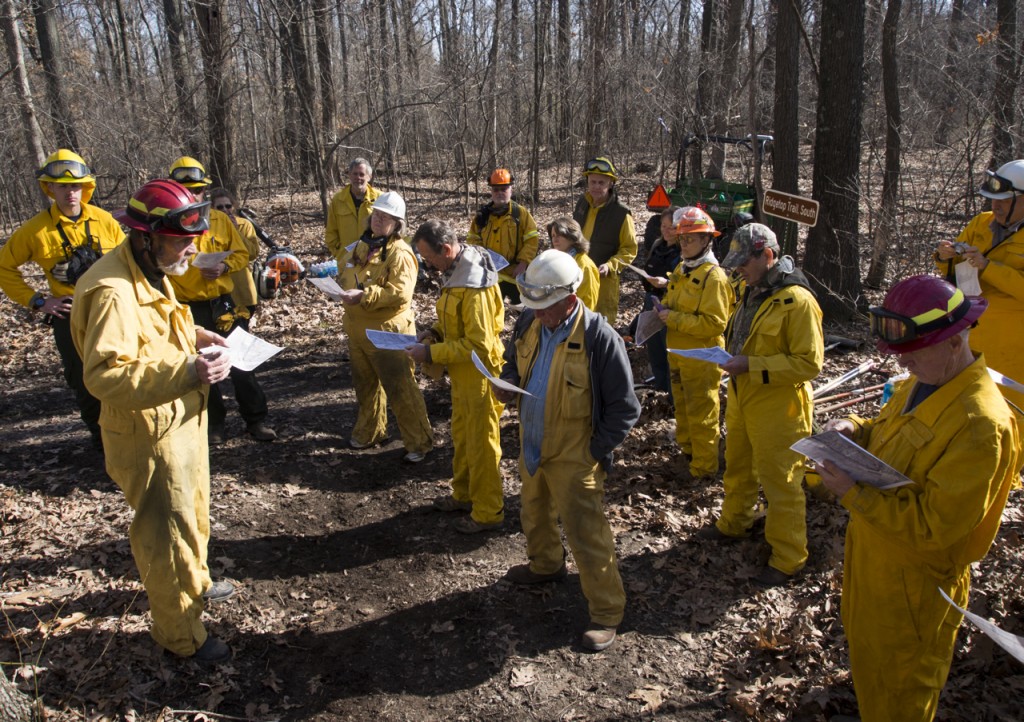
CLIFFhanger volunteers gather for a safety briefing March 31 before the controlled burn at White Rock Nature Preserve. The total 27-member crew, which in addition to volunteers, included contractors and personnel with the Illinois Department of Natural Resources, burned 170 acres with the cooperation of five landowners. Photo courtesy Tom Rollins, ThomasRollinsPhotography.com
A healthy high-functioning woodland, prairie or wetland composed of the plants and animals that evolved within that ecosystem holds soil in place and filters and absorbs rainwater. The absence of healthy native plants results in soil breakdown and reduced absorption capacity and leads to higher rain runoff rates and soil erosion. In time, soil erosion means silted waterways and wetlands and higher risk of flooding.
Healthy prairies and woodlands scrub carbon dioxide from the air and store carbon in plant material and soil. Some carbon dioxide certainly is released as smoke during a controlled fire and is a source of air pollution for the brief period of an actual fire. But this very temporary smoke pollution is offset by the tremendous growth spurt of plants, especially grasses, following a fire and the plants’ renewed and enhanced ability to clean the air during the hottest summer months when poor air quality is of greatest concern.
The services ecosystems provide – enhanced air quality, reduction in soil erosion, and carbon dioxide storage – depend upon the ecosystem’s overall health and fire, in controlled doses, is a prescription for health.
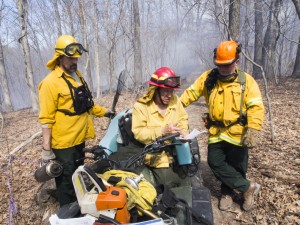
IDNR District Forester Mark Brown, Mike Fries, Fries & Associates, and CLIFFhanger Mike McCarrin confer during the prescribed burn at White Rock Nature Preserve. Photo courtesy Tom Rollins, ThomasRollinsPhotography.com
Our native plants evolved with fire on the landscape. Many plants depend on fire for seed germination, nutrient cycling into soils, and the creation of open tree canopies that then reduces competition for life-giving sunlight. Plants that are not adapted to occasional fire, like most non-native invasive species and native species that can become invasive, are set back. Our native oaks and hickories – the bulwarks of our forests – cannot regenerate in woodlands where bush honeysuckle, maples, Tree-of-Heaven, Japanese honeysuckle vines, and box elder trees have taken over the understory and shade out hickory and oak seedlings and associated wildflowers, mushrooms, sedges and grasses. A 60-year program of fire cessation dating from World War II correlates with the near-loss of self-sustaining oak-hickory forests throughout the eastern U.S. Before fire suppression, middle-aged, teen-aged and young oaks and hickories flourished in the dappled shade of their elder’s great heights. But fire suppression, intensive logging without follow-on forest management and the rapid spread of non-native invasive plants resulted in shade tolerant species taking over the understory. Oak and hickory seedlings simply can’t grow up into tomorrow’s forests under the shade of maples and invasive shrubs. Fire is a management tool that can bring back oak and hickory forests.
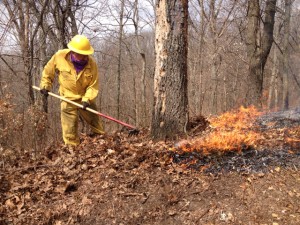
Bob Mohr, Salt Like Point Stewardship Committee, rakes leaves from a snag to ensure that the tree -- an important resource for wildlife -- does not catch fire during the March prescribed burn at the Reserve. Photo courtesy Joann Fricke, Clifftop.
Fire is equally beneficial for prairies and even more needed for their continued survival. Hill prairies, such as ours in southwestern Illinois, not only are clinging to the tops of cliffs, but also are clinging to a slender thread of existence itself. Less than 500 acres of hill prairie remain in the entire state and limestone glades, another notable natural system of our area, constitute an even smaller total state acreage. By definition, prairie and glade habitats are dominated by grass and flower species. Absence of fire has allowed woody species, including native cedar trees, sumacs and shrub dogwoods, along with non-native bush honeysuckle, to move into prairies and glades and replace open sunlit areas of grass and flowers. Fire helps reduce woody plant invaders and helps return our prairies and glades to a state of natural health. Because soil is an excellent insulator and fire adapted native plants have deep roots, grasses and flowers suffer no harm from the intense heat of a prairie fire.
In fact, during the very next growing season, prairies and glades show greatly enhanced growth, bloom, and even an increase in species diversity. Burning of dead plant material reduces mats of thatch that can prevent sunlight from reaching the earth and the ashes that are left soak into soils and provide a burst of nutrients. Plant species that had been struggling to grow through years of accumulated thatch or seeds unable to germinate without fire to scarify a tough outer cover, or, simply, plants that appreciate a good meal of naturally produced fertilizer recover, grow and flourish. And as they do so, animal species that depend on native plants also benefit from a new cycle of growth made possible by a prescribed fire’s dose of health.
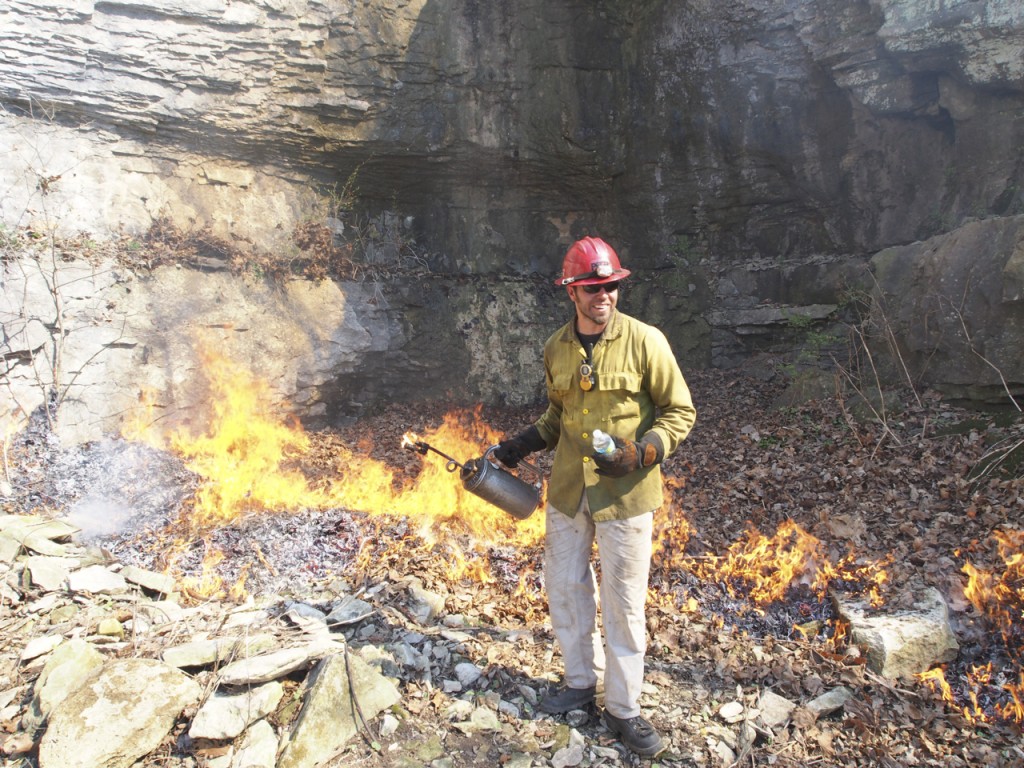
Bear Engbring begins the final lighting on the north flank line. Once the mile-long length of talus slope bordering Bluff Road was set, the loop of flame was closed around the total 170-acre unit of the prescribed burn at White Rock Nature Preserve. Photo coutesy Tom Rollins, ThomasRollinsPhotography.com
Prescribed fire, done well, enhances wildlife habitat and helps animal organisms within a natural ecosystem. Does fire kill? Yes it can and does. One of our primary purposes is that prescribed fires kill, or at least set back, select plant species. Does controlled fire kill animals? Again, the answer is a yes, but with important qualifications. Mammals are rarely harmed during a controlled burn, and birds, too, rarely suffer mortality from a burn. In fact, some bird species are attracted to burn areas, with bluebirds often flying in before smoke even clears, to the delight of burn crewmembers. Controlled burns in our area are done only in the dormant season: generally November through March or very early April, when animals such as snakes and turtles are not active and before most invertebrates, such as insects, are active. Invertebrates do suffer a level of harm from fire, as over-wintering eggs and larvae are consumed by flame. To provide as much protection as possible for these often keystone species, we refrain from burning entire habitat areas and types so that insect species can re-colonize from adjacent unburned areas. As research in our state and throughout the eastern U.S. has demonstrated, fire-sensitive native insect and other invertebrate species rapidly re-colonize burned areas. Long-term studies from the tallgrass prairie areas of Illinois show some of the highest population numbers of rare fire-sensitive butterfly and bee species in areas that are maintained with regular use of prescribed fire.
Fire is a management tool to help natural areas return to health. The ‘state of nature’ in our state is threatened with some habitats – our woodlands, prairies and wetlands – clinging to a slender thread. We hold one end of that thread in our collective hands. The landscape no longer is something out there and apart from us. It is a humanscape, ours to manage or to lose on a piece-by-piece basis. More than a century ago, bush and vine honeysuckles were planted in yards and gardens for their virtues as ornamental plants; some 60 years ago, suppression of all fire in natural areas became common. We can choose to let our one-time oak and hickory forests become acres of maples and honeysuckles and Tree-of-Heaven. We can ask our grandchildren to tell their children about one-time forays for mushrooms and hunts for turkey and deer in deep woods of oak, but to explain that those things don’t live here anymore because those forests exist only in memory. We can ask, as well, that they point to cliff tops overgrown with cedars and brush and tell about when flowers and grasses painted the area with color and were filled with butterflies, bees, and a great diversity of life. We can ask that they remember the addition to the family house was paid for by a timber sale, but that the woodlot never will produce such a bounty again because maple isn’t nearly as valuable as oak and maples are the only trees that sprouted and grew. We can ask or we can manage.
CLIFFTOP, a local nonprofit organization, is focused on preserving and protecting area bluff lands.
A version of this article appeared in the 17 April 2015 edition of the Monroe County Independent.
© 2015 all content rights reserved Clifftop NFP
Comments are currently closed.
